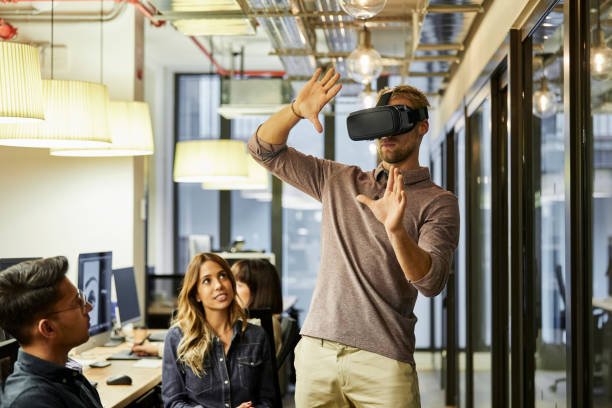Virtual reality (VR) design is a rapidly growing field that involves creating immersive, computer-generated environments for various industries such as gaming, entertainment, education, healthcare, and architecture. It is a subset of augmented reality (AR), which combines virtual elements with real-world environments. In this blog, we will explore the definition, evolution, nature, features, scope, major innovations, and career prospects in virtual reality design.
Meaning and Definitions of Virtual Reality and AR
Virtual reality is defined as “a computer-generated simulation of a three-dimensional environment that can be experienced and interacted with in a seemingly real or physical way.” AR, on the other hand, is defined as “a technology that superimposes digital information and images onto the real world, using a device’s camera and display.”
Both VR and AR are used to create an immersive experience for users, but VR provides a completely virtual environment, whereas AR enhances the real world.
Evolution of Virtual Reality Design
The concept of VR has been around since the 1960s, but it wasn’t until the 1990s that the first VR headsets were developed. In the early 2000s, VR began to gain popularity in the gaming industry, with games such as Second Life and World of Warcraft offering virtual environments for players to explore. In recent years, VR has expanded beyond gaming and is now being used in various industries, including architecture, product design, and healthcare.
Nature and Features of Interior Designing
Interior designing involves creating functional and visually appealing spaces for various purposes, such as residential, commercial, or industrial. Virtual reality interior design takes this process to the next level by allowing designers to create fully immersive experiences for clients.
With VR, designers can create accurate renderings of spaces, including textures, colors, and lighting, allowing clients to visualize and interact with their designs before they are built.
Scope of Designing in Virtual Reality and Augmented Reality
The scope of designing in VR and AR is vast and varied. In the architecture industry, VR allows architects to create detailed, interactive models of buildings and spaces, enabling clients to walk through and explore their designs before they are built. In product design, VR enables designers to create prototypes that can be tested and refined before production. In healthcare, VR is being used to create therapy environments for patients with anxiety disorders and post-traumatic stress disorder.
Some of the other important domains where designing in VR and AR is being applied are:
- Virtual reality home design: This is the process of creating and designing homes and interiors using VR technology. It allows homeowners and designers to visualize and customize their spaces in a realistic and immersive way.
- Virtual reality prototype design: This is the process of creating and designing prototypes of products or systems using VR technology. It allows designers and engineers to test and evaluate their designs in a simulated environment, without the need for physical fabrication.
- Interior design using virtual reality: This is the application of VR technology to the field of interior design. Virtual reality interior design allows interior designers and clients to create and explore different design options and scenarios in a virtual environment.
- Virtual reality design in multimedia: This is the use of VR technology to create and design multimedia content, such as games, films, animations, etc. It allows multimedia designers and artists to create immersive and interactive experiences for the users, using 3D graphics, sound, motion, and feedback.
- Virtual reality design tools: These are the software and hardware tools that are used to create and design in VR and AR. They include VR and AR devices, such as headsets, controllers, cameras, etc., as well as VR and AR software, such as game engines, 3D modeling tools, animation tools, etc.
- Virtual reality room design: This is the process of creating and designing rooms and spaces using VR technology. It allows users to customize and decorate their rooms in a virtual environment, using various furniture, accessories, colors, textures, etc.
- Virtual reality experience designer: This is a professional who creates and designs VR and AR experiences for various purposes, such as entertainment, education, training, marketing, etc. They are responsible for designing the content, interface, interaction, and feedback of the VR and AR experiences.
- Virtual reality graphic design: This is the process of creating and designing graphic elements, such as logos, icons, posters, etc., using VR technology. It allows graphic designers to create and manipulate 3D graphics in a virtual environment, using various tools and effects.
- Virtual reality in building design: This is the application of VR technology to the field of building design. It allows building designers and architects to create and design buildings and structures in a virtual environment, using various tools and features.
- Virtual reality interface design: This is the process of creating and designing the user interface and interaction of VR and AR experiences. It involves designing the elements, such as menus, buttons, icons, etc., that allow the users to navigate and control the VR and AR experiences.
- Virtual reality designer course: This is a course that trains and prepares students to become VR and AR designers. The virtual reality design course teaches them the skills and knowledge required to create and design VR and AR experiences, such as VR and AR fundamentals, design tools and techniques, user interface and interaction design, storytelling and narrative design, etc.
Major Innovations in VR and AR Designing
Recent innovations in VR and AR designing include the development of affordable VR headsets, such as Oculus Go and Google Daydream, which have made VR accessible to a wider audience. Another major innovation is the integration of artificial intelligence (AI) and machine learning algorithms into VR and AR systems, enabling more realistic interactions and personalized experiences.
How to Make a Career in VR and AR Designing
To make a career in VR and AR designing, one needs to have a combination of technical and creative skills. Some of the key skills required include proficiency in programming languages such as C++, Java, and Python, knowledge of 3D modeling software such as Blender and Maya, and experience with game engines such as Unity and Unreal Engine.
Additionally, having a good understanding of human-computer interaction and user experience design is crucial. There are several courses and training programs available for those looking to enter the field, including online courses.
Conclusion
Virtual reality design is a rapidly growing field that offers endless possibilities for creative and technical individuals. From architecture to product design to healthcare, VR and AR are transforming the way we interact with and experience the world around us. Whether you are a seasoned designer or just starting out, there has never been a better time to explore the exciting world of virtual reality design.




